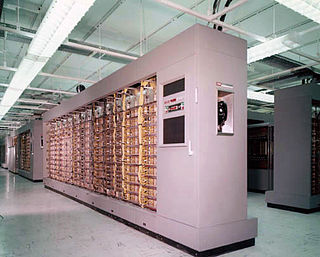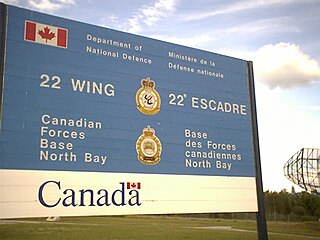
The Semi-Automatic Ground Environment (SAGE) was a system of large computers and associated networking equipment that coordinated data from many radar sites and processed it to produce a single unified image of the airspace over a wide area. SAGE directed and controlled the NORAD response to a possible Soviet air attack, operating in this role from the late 1950s into the 1980s. Its enormous computers and huge displays remain a part of cold war lore, and after decommissioning were common props in movies such as Dr. Strangelove and Colossus, and on science fiction TV series such as The Time Tunnel.

The RCA 474L Ballistic Missile Early Warning System was a United States Air Force Cold War early warning radar, computer, and communications system, for ballistic missile detection. The network of twelve radars, which was constructed beginning in 1958 and became operational in 1961, was built to detect a "mass ballistic missile attack launched on northern approaches [for] 15 to 25 minutes' warning time" also provided Project Space Track satellite data.

The AN/FSQ-7 Combat Direction Central, referred to as the Q7 for short, was a computerized command and control system for Cold War ground-controlled interception used in the USAF Semi-Automatic Ground Environment (SAGE) air defense network.

The National Military Command Center (NMCC) is a Pentagon command and communications center for the National Command Authority. Maintained by the Department of the Air Force as the "DoD Executive Agent" for NMCC logistical, budgetary, facility and systems support; the NMCC operators are in the Joint Staff's J-3 (Operations) Directorate. "The NMCC is responsible for generating Emergency Action Messages (EAMs) to missile launch control centers, nuclear submarines, recon aircraft and battlefield commanders".

The Raven Rock Mountain Complex (RRMC), also known as Site R, is a U.S. military installation with an underground nuclear bunker near Blue Ridge Summit, Pennsylvania, at Raven Rock Mountain that has been called an "underground Pentagon". The bunker has emergency operations centers for the United States Army, Navy, Air Force and Marine Corps. Along with Mount Weather Emergency Operations Center in Virginia and the Cheyenne Mountain Complex in Colorado, it formed the core bunker complexes for the US continuity of government plan during the Cold War to survive a nuclear attack.

Librascope was a Glendale, California, division of General Precision, Inc. (GPI). It was founded in 1937 by Lewis W. Imm to build and operate theater equipment, and acquired by General Precision in 1941. During World War II it worked on improving aircraft load balancing.
The IBM AN/FSQ-31 SAC Data Processing System was a USAF command, control, and coordination system for the Cold War Strategic Air Command (SAC). IBM's Federal Systems Division was the prime contractor for the AN/FSQ-31s, which were part of the TBD 465L SAC Automated Command and Control System (SACCS), a "Big L" system of systems (cf. 416L SAGE & 474L BMEWS( which had numerous sites throughout the Continental United States: "all SAC command posts and missile LCC's", a communication network, etc.; and the several FSQ-31 sites including:

The AN/FSQ-32 SAGE Solid State Computer was a planned military computer central for deployment to Super Combat Centers in nuclear bunkers and to some above-ground military installations. In 1958, Air Defense Command planned to acquire 13 Q-32 centrals for several Air Divisions/Sectors.

The Space Defense Center (SDC) was a space operation center of the North American Aerospace Defense Command. It was successively housed at two Colorado locations, Ent Air Force Base, followed by Cheyenne Mountain's Group III Space Defense Center The 1st Aerospace Control Squadron manned the SDC at both locations, which used the Electronic Systems Division's 496L System for processing and displaying data combined from the U.S. "Air Force's Space Track and the Navy's Spasur" (NAVSPASUR).
Backup Interceptor Control was the Electronic Systems Division 416M System to backup the SAGE 416L System in the United States and Canada. BUIC deployed Cold War command, control, and coordination systems to SAGE radar stations to create dispersed NORAD Control Centers.

The Fort Heath radar station was a USAF radar site and US Army Missile Master installation of the joint-use site system (JUSS) for North American Air Defense at a former coastal defense site. The Cold War radar station had 2 USAF AN/FPS-6B height finding radars, 2 Army AN/FPS-6A height finders, an FAA ARSR-1 radar emplaced 1958-9, and an Army nuclear bunker. Arctic Towers were the pedestals for the FPS antennas and radomes, while the Air Route Surveillance Radar was on a 50-foot extension temperate tower adjacent to the Federal Aviation Administration building.
The GE AN/GPA-73 Radar Course Directing Group was a US Cold War air defense command, control, and coordination system developed for the Electronic Systems Division 412L Air Weapons Control System for weapons direction. The AN/GPA-73 was used to create a "Base Air Defense Ground Environment", for which Air Defense Command had recommended the system as "SAGE back-up control of BOMARC" in June 1958. When the GPA-73 was emplaced with the AN/FSA-21 Weapons Control Group computer for GCI, the system created a "miniature SAGE" military installation. The GPA-73 could also direct Project Nike surface-to-air missile fire from Nike Integrated Fire Control sites equipped with the "412 Target Designation System" in the Battery Control Van in a space allocated by February 1957 "behind the Acquition Operator [sic]". and the AN/GPA-73.
An Air Defense Direction Center (ADDC) was a type of United States command post for assessing Cold War radar tracks, assigning height requests to available height-finder radars, and for "Weapons Direction": coordinating command guidance of aircraft from more than 1 site for ground-controlled interception. As with the World War II Aircraft Warning Service CONUS defense network, a "manual air defense system" was used through the 1950s Along with 182 radar stations at "the end of 1957, ADC operated … 17 control centers", and the Ground Observation Corps was TBD on TBD. With the formation of NORAD, several types of ADDCs were planned by Air Defense Command:
NORAD Control Centers (NCCs) were Cold War "joint direction centers" for command, control, and coordination of ground-controlled interception by both USAF Air Defense Command (ADC) and Army Air Defense Command (ARADCOM). The Joint Manual Steering Group was "formed by the Army and Air Force in July 1957 to support…collocation" of USAF Air Defense Direction Centers and Army Air Defense Command Posts, which began after a January 28, 1958, ADC/ARADCOM meeting with NORAD to "collocate the Fairchild-Geiger facilities" Army contracts for 5 NCCs had been let by August 17, 1958, after 1956 DoD approval for collocation of interim "pre-SAGE semiautomatic intercept systems" and radar squadrons at 10 planned Army Missile Master AADCPs
The Experimental Semi-Automatic Ground Environment (SAGE) Sector was a prototype Cold War Air Defense Sector for developing the Semi Automatic Ground Environment. The Lincoln Laboratory control center in a new building was at Lexington, Massachusetts.

The ITT 465L Strategic Air Command Control System was a Cold War "Big L" network of computer and communication systems for command and control of Strategic Air Command "combat aircraft, refueling tankers, [and] ballistic missiles". International Telephone and Telegraph was the prime contractor for Project 465, and SACCS had "Cross Tell Links" between command posts at Offutt AFB, March AFB, & Barksdale AFB (SACCS also communicated with the Cheyenne Mountain Complex and Air Force command posts. The 465L System included IBM AN/FSQ-31 SAC Data Processing Systems, Remote and Simplex Remote Communication Systems, SAC Network Control Office, "4-wire, Schedule 4, Type 4B alternate voice-data operation", and one-way communication with "ICBM launch control centers" In addition to IBM for the "Super SAGE type computers", another of the 6 direct subcontractors was AT&T,
The National Military Command System (NMCS) was the federal government of the United States' Cold War command and control system that consisted of the National Military Command Center (NMCC) at The Pentagon, the Alternate National Military Command Center (NMCC) at Pennsylvania Raven Rock Mountain, 3 National Emergency Airborne Command Post (NEACP) aircraft on 24-hour ground alert, 2 National Emergency Command Post Afloat (NECPA) ships, "and interconnecting communications".

Iconorama was a Cold War electronic projection system for graphic presentation developed by the firm Fenske, Fedrick and Miller. The Iconorama was ordered by the United States Air Force in 1959.

The Missile Warning Center (MWC) is a center that provides missile warning and defense for United States Space Command's Combined Force Space Component Command, incorporating both space-based and terrestrial sensors. The MWC is located at Cheyenne Mountain Space Force Station.
FYQ-93 was a computer system used from 1983–2006, and built for the Joint Surveillance System (JSS) by the Hughes Aircraft Company. The system consisted of a fault tolerant central computer complex using a two string concept that interfaced with many display consoles and interfaced with external radars to provide a region-sector display of air traffic.










